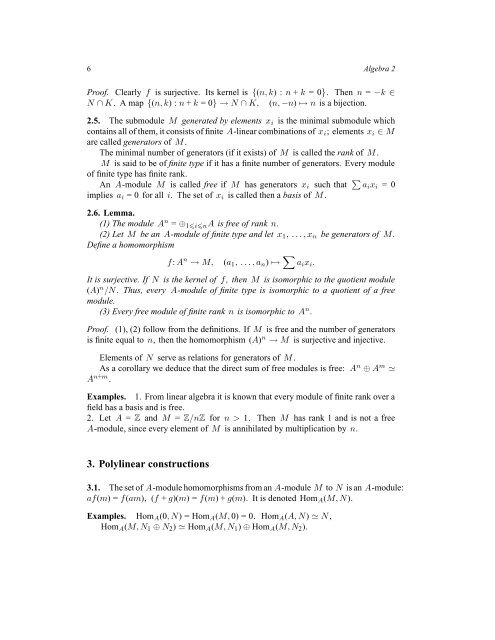Algebra (Unknown 27). - Index of
Algebra (Unknown 27). - Index of
Algebra (Unknown 27). - Index of
Create successful ePaper yourself
Turn your PDF publications into a flip-book with our unique Google optimized e-Paper software.
6 <strong>Algebra</strong> 2<br />
Pro<strong>of</strong>. Clearly f is surjective. Its kernel is {(n, k) : n + k = 0}. Then n = −k ∈<br />
N ∩ K. A map {(n, k) : n + k = 0} → N ∩ K, (n, −n) ↦→ n is a bijection.<br />
2.5. The submodule M generated by elements x i is the minimal submodule which<br />
contains all <strong>of</strong> them, it consists <strong>of</strong> finite A-linear combinations <strong>of</strong> x i ; elements x i ∈ M<br />
are called generators <strong>of</strong> M .<br />
The minimal number <strong>of</strong> generators (if it exists) <strong>of</strong> M is called the rank <strong>of</strong> M .<br />
M is said to be <strong>of</strong> finite type if it has a finite number <strong>of</strong> generators. Every module<br />
<strong>of</strong> finite type has finite rank.<br />
An A-module M is called free if M has generators x i such that ∑ a i x i = 0<br />
implies a i = 0 for all i. The set <strong>of</strong> x i is called then a basis <strong>of</strong> M .<br />
2.6. Lemma.<br />
(1) The module A n = ⊕ 1in A is free <strong>of</strong> rank n.<br />
(2) Let M be an A-module <strong>of</strong> finite type and let x 1 , . . . , x n be generators <strong>of</strong> M .<br />
Define a homomorphism<br />
f: A n → M, (a 1 , . . . , a n ) ↦→ ∑ a i x i .<br />
It is surjective. If N is the kernel <strong>of</strong> f , then M is isomorphic to the quotient module<br />
(A) n /N . Thus, every A-module <strong>of</strong> finite type is isomorphic to a quotient <strong>of</strong> a free<br />
module.<br />
(3) Every free module <strong>of</strong> finite rank n is isomorphic to A n .<br />
Pro<strong>of</strong>. (1), (2) follow from the definitions. If M is free and the number <strong>of</strong> generators<br />
is finite equal to n, then the homomorphism (A) n → M is surjective and injective.<br />
Elements <strong>of</strong> N serve as relations for generators <strong>of</strong> M .<br />
As a corollary we deduce that the direct sum <strong>of</strong> free modules is free: A n ⊕ A m ≃<br />
A n+m .<br />
Examples. 1. From linear algebra it is known that every module <strong>of</strong> finite rank over a<br />
field has a basis and is free.<br />
2. Let A = Z and M = Z/nZ for n > 1. Then M has rank 1 and is not a free<br />
A-module, since every element <strong>of</strong> M is annihilated by multiplication by n.<br />
3. Polylinear constructions<br />
3.1. The set <strong>of</strong> A-module homomorphisms from an A-module M to N is an A-module:<br />
af(m) = f(am), (f + g)(m) = f(m) + g(m). It is denoted Hom A (M, N).<br />
Examples. Hom A (0, N) = Hom A (M, 0) = 0. Hom A (A, N) ≃ N ,<br />
Hom A (M, N 1 ⊕ N 2 ) ≃ Hom A (M, N 1 ) ⊕ Hom A (M, N 2 ).

















